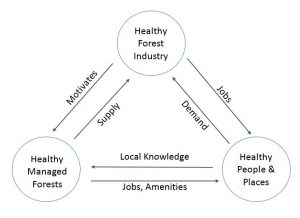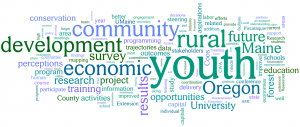Forest Economics and Management Lab Research
 My research is focused on three main topic areas: the forest products industry, forest management, and rural communities. Each of these are connected with and reliant on each other, and of critical interest to the state of Maine and many other forested regions. People rely on wood products and the local jobs generated from forest uses (including non-consumptive uses); the industry relies on active management to supply wood. The demand for wood motivates management and supports rural communities and economies. All these connections and interactions motivate my research, and a working forest landscape like Maine is a natural laboratory.
My research is focused on three main topic areas: the forest products industry, forest management, and rural communities. Each of these are connected with and reliant on each other, and of critical interest to the state of Maine and many other forested regions. People rely on wood products and the local jobs generated from forest uses (including non-consumptive uses); the industry relies on active management to supply wood. The demand for wood motivates management and supports rural communities and economies. All these connections and interactions motivate my research, and a working forest landscape like Maine is a natural laboratory.
Below is a brief description of current research projects in the areas of Economic Impacts and Valuation, Rural Communities, and Forest Management.
Economic Impacts and Valuation: Sometimes, putting a number on something is really useful – it allows us to demonstrate, in an easily understandable way, the importance of it.
Forest Products. We have recently updated information about the importance of the forest products industry to the state, and also looked at the impacts of mill closures and potential biofuels development.
Doctoral student: James Anderson III
Key results:
- The Forest Products Industry contributes over $8 billion to Maine’s economy.
- Anderson III, James L. and Mindy S. Crandall. 2016. Economic Contributions of Maine’s Forest Products Industry in 2014, with adjustments to 2016. Report prepared for the Maine Forest Products Council, 11p.
- “Maine’s Forest Economy“, available from the Maine Forest Products Council.
- There’s some role for emerging technologies (such as the production of woody-biomass based fuels) to help support rural communities, but it tends to be highly site-specific and limited. There are opportunities to support emerging technologies as an important part of diversification strategies for rural forest-dependent places, not as silver bullets.
- Crandall, Mindy S. , James L. Anderson, and Jonathan Rubin. “Impacts of Recent Mill Closures and Potential Biofuels Development on Maine’s Forest Products Industry.” Maine Policy Review 26.1 (2017) : 15 -22, http://digitalcommons.library.umaine.edu/mpr/vol26/iss1/4.
- Crandall, Mindy S., Darius Adams, Claire A. Montgomery, and David Smith. 2017. The Potential Rural Development Impacts of Utilizing Non-Merchantable Forest Biomass. Forest Economics and Policy 74: 20-29. DOI: 10.1016/j.forpol.2016.11.002.
This work was supported by the NSF SEP, Maine Agricultural and Forest Experiment Station (MAFES), USDA-ARS, and USDA-NIFA-AFRI.
What we’re working on now:
- Developing a market model of the forest products industry. This forward-looking model mimics demand (what the mills want) and supply (what the forests are) over time, in a market context. The model will allow us to explore questions like:
- What would happen if much of the forest died from a Spruce budworm outbreak, and extensive salvage harvests took place?
- What would happen if new bio-refineries were built in the state?
- What would happen to the market if new harvest restrictions were enacted?
This work is supported by USDA-ARS and MAFES.
Conservation Lands. What is the value that conservation lands bring to an area?
Master’s student: Lesley Lichko
What we’re working on now:
- In collaboration with the Downeast Conservation Network (formerly DEREN) and the University of Maine at Machias, we’re creating a comprehensive look at the values that conservation lands provide in Downeast Maine using an Ecosystems Services framework.
This work is supported by the University of Maine Research Reinvestment Fund, the Downeast Conservation Network, and MAFES.
Rural communities are important on our landscape for many reasons. Their continued survival depends on them being vibrant places for people to live and work. People’s interactions with local labor markets are a key driver of people’s livelihoods, and in forested places, that usually means jobs in timber, recreation/tourism, or a mix of the two. These different types of jobs have implications for the local communities, and aren’t often well understood; and as industries transition from one to another, what does that mean for rural community stability?
 Rural Youth Futures: What are the goals and aspirations of youth on the verge of entering the labor market in rural, forest-dependent communities?
Rural Youth Futures: What are the goals and aspirations of youth on the verge of entering the labor market in rural, forest-dependent communities?
Doctoral Student: Nicole Bernsen
What we’re working on now:
- This project asks middle-school and high-school youth in two forest-dependent counties (Piscataquis County, Maine, and Coos County, Oregon) about their labor market perceptions and aspirations for the future. We’re combining ideas about labor market incentives, human capital investments, sociology and social psychology to try to understand the connections between community conditions and youth futures.
- We hope to learn:
- Do youth have accurate perceptions of labor market opportunities and economic trajectories?
- How are perceptions and aspirations influenced by individual, economic, and community demographic characteristics?
- Are community trajectories related to differences in aspirations and plans for human capital?
- Are community trajectories related to youth desires to remain, return, or leave?
- This project is in collaboration with the Appalachian Mountain Club and the Coos Watershed Association, along with University of Maine Cooperative Extension and the Ecosystem Workforce Program at the University of Oregon. The integration across educational programs and outreach programs will enable the research results to inform program development targeting skills and goals that rural youth have and want.
This work is supported by USDA-NIFA-AFRI.
Rural Communities in Transition. What can we learn about rural communities “in the middle” – those neither wilderness nor suburbs – that are experiencing economic shocks? Are there community-level factors that are related to the outcome of a place – whether it reorganizes into new production economies, amenity-based economies, or slides into decline?
What we’re working on now:
- This project builds off previous work and is using a multi-scale approach, including secondary data analysis, key informant interviews, and mail surveys, to address some of these questions.
- See Morzillo, A.T., Colocousis, C.R., Munroe, D.K., Bell, K.P., Martinuzzi, S., Van Berkel, D.B., Lechowicz, M.J., Rayfield, B., McGill, B., 2015. “Communities in the middle”: Interactions between drivers of change and place-based characteristics in rural forest-based communities. J. Rural Stud. 42, 79–90. doi:10.1016/j.jrurstud.2015.09.007
This work is supported by USDA-NIFA-AFRI.
Workforce Assessment of the Forest Products Industry. How well are supply and demand matching up in the state of Maine?
Doctoral Student: Nicole Gayer Bernsen
What we’re working on now:
- We delivered a survey to current forest industry businesses, as well as current and recent graduates of forestry-related programs in the state (four CTE programs in high schools, a two-year program at the University of Maine Fort Kent, and the four-year program at the University of Maine) to assess their perceptions of needed skills in the forest industry workforce.
- Data analysis will include an overview of the current state of labor supply and demand in the forest industry along with an analysis of gaps in skills and training.
This work is supported by USDA-ARS.
Issues in Forest Management: How we manage our forests is intertwined with market incentives, landowner goals, and the local environment. In addition, how we manage trees today directly impacts what benefits we will get out of them – whether you’re talking about market benefits (lumber for your house or paper for your office) or non-market benefits (like soil nutrient cycling, water purification, a place to recreate in, or the beautiful view that helps define Vacationland). Making sure that landowners have the tools and resources to best manage forests is critical to retaining working forests across a landscape that provide all those benefits we all use and enjoy.
Sustainable Forest Management: New Outreach Tools and Findings. Just 20 miles away from the UMaine campus and the home of SFR lies an amazing resource: the Penobscot Experimental Forest. For more than sixty years, long-term experiments in silviculture have recorded the stand-level effects of various treatments that are common on the Maine landscape.
Master’s student: Maren Granstrom
What we’re working on now:
- This project will analyze the data to glean new insights into the myriad outcomes from different silvicultural regimes, including metrics related to ecological outcomes, economic outcomes, and wildlife habitat outcomes.
- The results will be compiled in accessible, easy-to-understand guides to silvicultural options targeted towards landowners and land managers.
- This project is in collaboration with the U.S. Forest Service’s Northern Research Station.
This work is supported by the U.S. Forest Service.
Impacts of wildlife habitat regulations on forest management: economic and spatial analysis of deer wintering areas.
Master’s Student (completed): Karin Bothwell
Key Results:
- Deer policy in Maine is unique and often a point of dispute between biologists and forest managers. However, we found that managing deer wintering areas is not necessarily a financial loss for landowners. The species composition and effects of previous treatments seem to drive the potential financial returns more than managing for deer in any given stand.
- Novel silvicultural practices, such as a Femelschlag-style system that is modeled on the PEF, have great potential to provide decent financial returns and may also provide a good matrix of habitat for deer. These systems may be acceptable to both biologists and foresters.
- It remains difficult to translate current conditions as well as projected outcomes of silvicultural treatments into meaningful wildlife habitat metrics, because the metrics that biologists are interested in aren’t typically represented in a standard forest inventories or in standard forest modeling programs. Better integration of needed metrics may allow foresters and biologists to speak the same language and be more comfortable experimenting with new silvicultural ideas.
This work was supported by MAFES and the Cooperative Forestry Research Unit.

